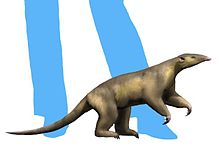
Back Eurotamandua joresi Catalan Eurotamandua German Eurotamandua Spanish مورچهخوار درختی اروپایی Persian Eurotamandua French אירוטמנדואה HE Eurotamandua Hungarian Eurotamandua joresi Italian Eurotamandua Latin Eurotamandua Maltese
| Eurotamandua Temporal range: Middle Eocene
| |
|---|---|

| |
| Fossil of Eurotamandua joresi | |

| |
| Life reconstruction of Eurotamandua joresi | |
| Scientific classification | |
| Domain: | Eukaryota |
| Kingdom: | Animalia |
| Phylum: | Chordata |
| Class: | Mammalia |
| Order: | Pholidota |
| Family: | †Eurotamanduidae Szalay & Schrenk, 1994[2] |
| Genus: | †Eurotamandua Storch, 1981[1] |
| Type species | |
| †Eurotamandua joresi Storch, 1981
| |
Eurotamandua ("european Tamandua") is an extinct genus of mammal from extinct family Eurotamanduidae that lived during the middle Eocene.[3]
A single fossil is known, coming from the Messel Pit in southwestern Germany. Eurotamandua was about 90 cm (35 in) long. Most palaeontologists now classify Eurotamandua as a pangolin. When its fossils were first discovered, Eurotamandua was originally thought to be an anteater, as it lacked the characteristic fused-hair scales of other pangolins. Eurotamandua's placement within the pangolins was made primarily because of a lack of the characteristic "xenarthran" joints found in all xenarthrans, including tamanduas.
There is still much ambiguity in the taxonomy of all mammals prior to the Eocene, so there is the possibility that Eurotamandua was a primitive xenarthran. However, this is highly unlikely because all known fossil evidence indicates that xenarthrans existed exclusively in South America from the beginning of the Cenozoic era until the formation of the Panama land bridge 3 million years ago, after which they spread to North America (but never to Eurasia or Africa). Another possibility is that Eurotamandua belongs to another group of mammals which appeared around its time, the Afredentata (probably part of Afrotheria).[4] Eurotamandua is currently thought to be a stem-pangolin, closer to crown pangolins than Palaeanodonta and Euromanis but more basal than Eomanis and Necromanis.[5]
- ^ Gerhard Storch: "Eurotamandua joresi, ein Myrmecophagide aus dem Eozän der "Grube Messel" bei Darmstadt (Mammalia, Xenarthra)." Senckenbergiana lethaea 61 (3/6), (1981), S. 247–289
- ^ "Abstracts of Papers". Journal of Vertebrate Paleontology. 14: 1–58. 1994. Bibcode:1994JVPal..14S...1.. doi:10.1080/02724634.1994.10011592.
- ^ Delsuc, Frédéric; Vizcaíno, Sergio F.; Douzery, Emmanuel JP (28 April 2004). "Influence of Tertiary paleoenvironmental changes on the diversification of South American mammals: a relaxed molecular clock study within xenarthrans". BMC Evolutionary Biology. 4 (1): 11. doi:10.1186/1471-2148-4-11. ISSN 1471-2148. PMC 419338. PMID 15115541.
- ^ Hunter, John P. and Janis, Christine M. 2006. "Spiny Norman in the Garden of Eden? Dispersal and early biogeography of Placentalia." J Mammal Evol 13:89–123
- ^ Cite error: The named reference
web2.utc.eduwas invoked but never defined (see the help page).
© MMXXIII Rich X Search. We shall prevail. All rights reserved. Rich X Search